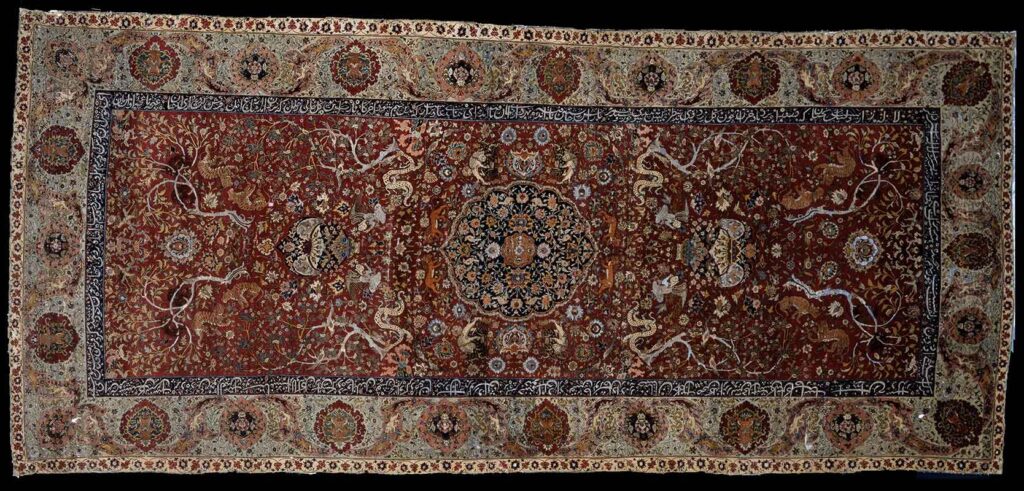Hunting Carpet
Tabriz , 1522 - 1523
Description

The carpet features the traditional medallion layout with four corner motifs placed on a dark blue background field. The medallion has sixteen points, with pendants; it has a red background, with a complex decoration of birds and “cloud bands” (a curvilinear motif of Chinese origin), connected by a dense flowery lattice. In the center of the medallion is an inscription translated as follows, “By the labors of Ghyas el Din Jami this renowned work was brought to such splendid completion in the year 949” (Pope, 1927, p. 85). The four motifs at the corners are quarter pendant medallions, also with a red background. The blue field depicts various hunting scenes, men on horseback with bows, wild and fantastic animals, and birds. This is one of the possible symbolic representations of the Garden of Eden: the fighting animals would represent the eternal combat between vice and virtue, the hunting princes on the other hand the quest for spiritual elevation through overcoming the self.
As within the medallion, the motifs are joined by a thin lattice that also connects a minute floral decoration. The main border, on the other hand, features a row of palmettes connected by broad sinuous stripes. The carpet consists of several fragments, and the missing parts were woven in tapestry stitch, perhaps in Florence between 1875 and 1900 by the tapestry maker Castellani (Mottola Molfino, 1977-1978, p. 2) or in 1895 by the tapestry maker Gentili in Rome (Pope, 1927, p. 106). One of the lost fragments (48 x 135 cm.) donated by Alessandro Bruschettini, was rejoined to the carpet in 2008, sewn in its original position. There is a dispute regarding the date of execution visible in the center of the rug in the inscription. The second digit is in fact imperfect and can be read either “2” or “4,” so the date could be either 929 Year of the Hegira (1522-1523) or 949 (1542-1543), the latter date being more justifiable from a stylistic point of view.
In fact, the carpet has a rather stiff arabesque border, and at the corners the design does not flow perfectly. All this makes the border inappropriate for the much more refined and better composed field decoration. The other dated carpet from the same period, the famous “Ardabil” carpet from the Victoria and Albert Museum in London, dated 1539, has a denser knotting and a consequent precision of line and an overall quality of design that is far superior. It therefore does not appear that the carpet could predate the “Ardabil” carpet, and this is also the opinion of scholars who more recently observed our piece at the exhibition, held in London at the Hayward Gallery in 1976 (Hayward Gallery, 1976, p. 98). The name marked in the inscription “Ghiyas [Ghyas] el Din Jami” also appears on a 16th-century Persian brocade and velvet (Pope, 1927, p. 88). This would suggest that “Ghiyas” is the designer of these three works, but no documents have been found to support this hypothesis. It is likely, however, that this carpet, like other sixteenth-century Safavid court products, was designed by a court miniaturist given the similarity between details found on miniatures and carpets of the period (Dimand Mailey, 1973, p. 43).
Data Sheet
Author
Tabriz (?)
Date
1522 - 1523
Material and technique
wool (knot); silk (warp); cotton (weft, knot)
Measures
353 cm x 682 cm
Acquisition
long-term loan from Pinacoteca di Brera, 1923
Inventory number
D.T. 0001
location
Fresco Room
The Fresco Room owes its name to the large ceiling fresco by Lombard painter Carlo Innocenzo Carloni, the Apotheosis of Bartolomeo Colleoni. The fresco, which comes from Villa Colleoni in Calusco d’Adda, was transferred to the Museum during postwar reconstruction work. On display in the showcase on the wall opposite the entrance is the magnificent Hunting Carpet, a unique example from northwestern Persia and dated 1542/1543. The room is also dedicated to hosting temporary exhibitions, lectures and conferences.
collection
Textiles
The heterogeneous textile collection includes important antique Persian carpets, Renaissance tapestries and 180 textiles dating from the 14th to the 18th century. Among them, rare Italian velvets and precious 15th century Lombard altar frontals. Antique Coptic textiles and Lombard and Flemish laces and embroideries, dating from the 18th and the 19th century, were acquired or received as donations.
